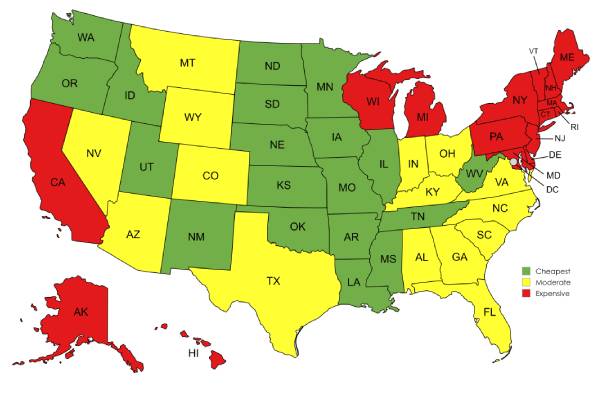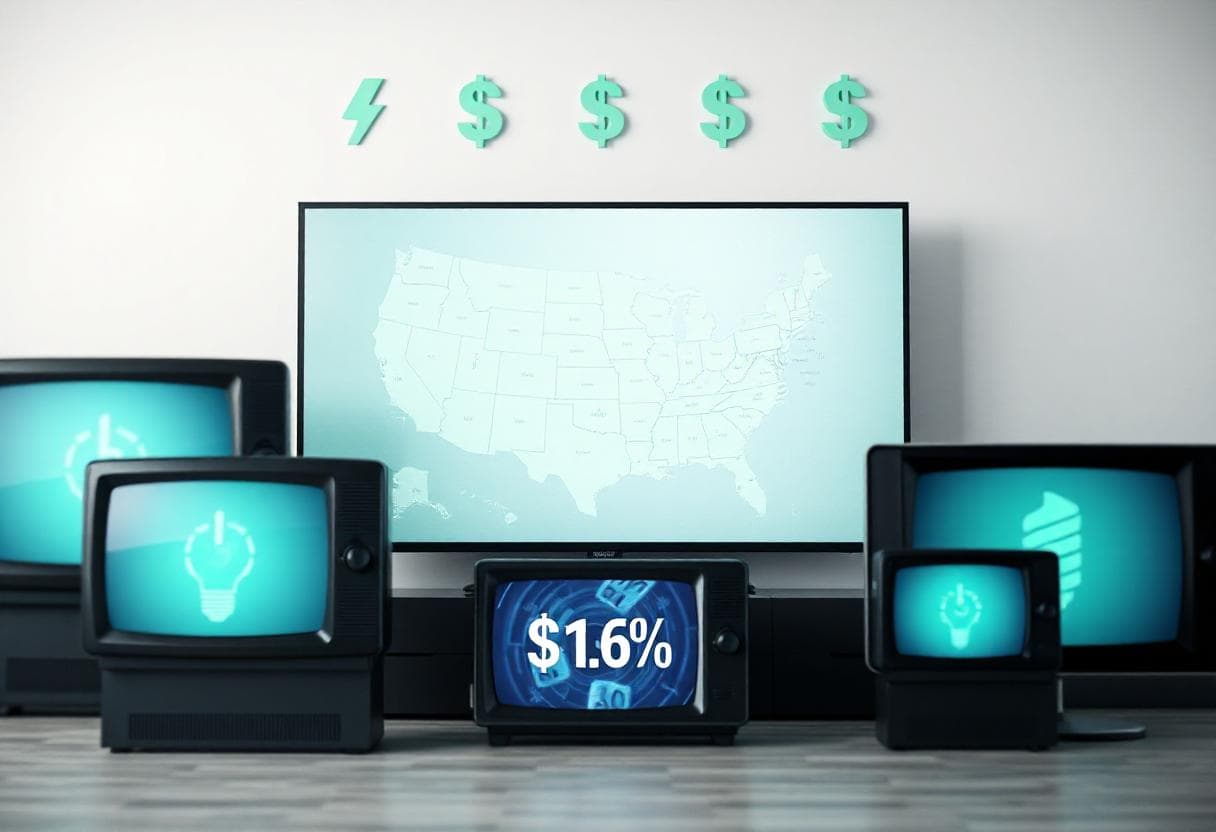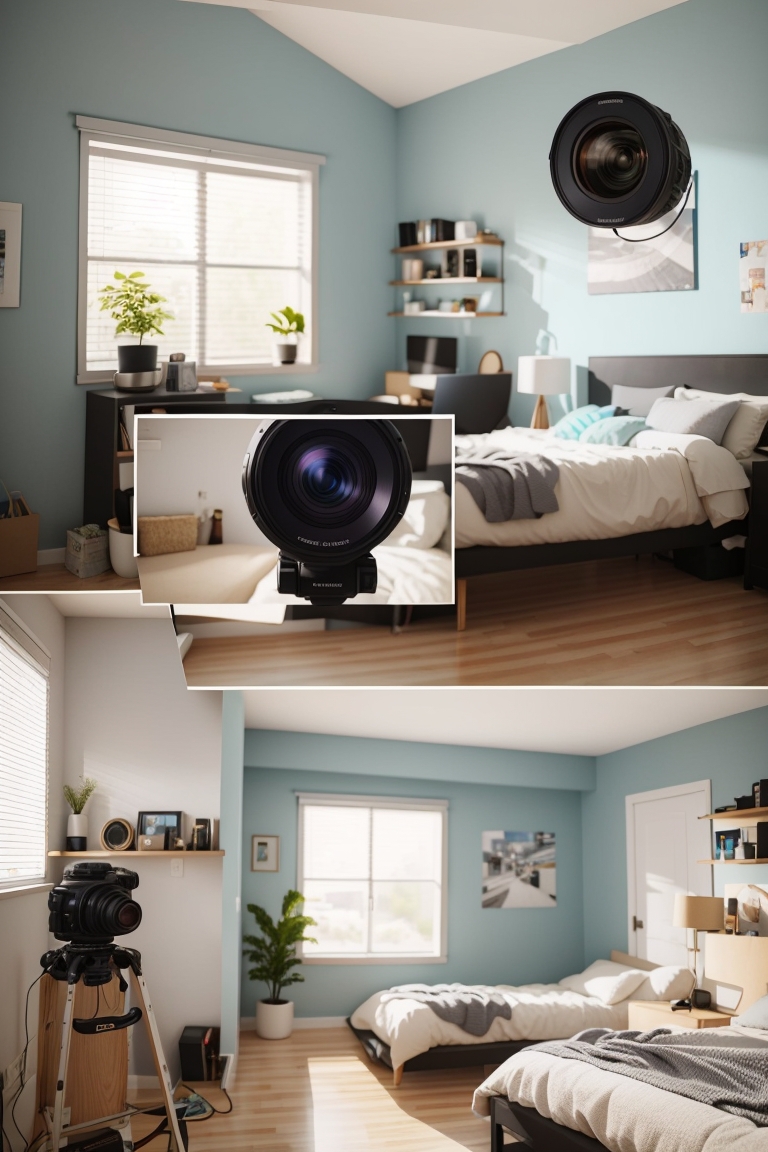Understanding LED TV wattage is crucial for managing your energy consumption and Reducing electricity costs. With energy efficiency becoming more important, knowing how many watts your TV uses can help you make informed decisions. In this guide, we’ll break down TV power consumption by size, explore the factors affecting energy usage, and provide detailed data tables showing the cost of powering different TV sizes across U.S. states.
Key Takeaways About TV Wattage
- LED TV wattage varies depending on the size and technology of the TV.
- TV electricity usage can significantly impact your utility bills, especially for larger screens and longer usage times.
- Understanding TV power consumption helps in making energy-efficient decisions and saving on electricity costs.
How Many Watts Does a TV Use?
The wattage of an LED TV primarily depends on its size. Larger TVs generally use more electricity. Here’s a quick overview of the average TV wattage for different sizes:
| TV Size | Average Wattage (Watts) |
|---|---|
| 15-inch | 20 W |
| 17-inch | 25 W |
| 19-inch | 28 W |
| 20-inch | 30 W |
| 22-inch | 35 W |
| 24-inch | 40 W |
| 30-inch | 50 W |
| 32-inch | 55 W |
| 37-inch | 65 W |
| 40-inch | 70 W |
| 42-inch | 75 W |
| 50-inch | 90 W |
| 60-inch | 110 W |
| 65-inch | 120 W |
These TV power usage figures represent average consumption, but actual usage may vary based on brightness settings, content type, and other factors.
How Much Electricity Does a TV Use?
To estimate the electricity usage of a TV, you can use the following formula:
Electricity Usage (kWh) = Power Consumption (kW) × Hours of Use
For instance, if you use a 50-inch LED TV with a power consumption of 90 watts (0.09 kW) for 5 hours per day:
Electricity Usage=0.09kW×5hours/day×365days/year=164.25kWh/year
This consumption directly influences the cost to run a TV, which we’ll explore further with state-specific data tables.
How Many Amps Does a TV Use?
To calculate the amperage (current) your TV draws, use the formula:
Current (Amps) = Power Consumption (Watts) / Voltage (Volts)
For a 50-inch LED TV using 90 watts on a standard 120V outlet in the U.S.:
Current= 120V / 90W = 0.75A
What Are The Factors Affecting TV Wattage?
Several factors influence the wattage of a TV and its overall energy consumption:
- Screen Size: Larger screens generally consume more power.
- Brightness Settings: Higher brightness increases energy consumption.
- Content Type: High-definition or 4K content typically requires more energy.
- Usage Duration: Longer usage times lead to higher electricity usage.
- External Devices: Connecting gaming consoles or sound systems can increase overall power usage.
How to Determine TV Power Consumption?
To accurately determine your TV’s power consumption:
- Check the Manufacturer’s Label: Most TVs list their wattage on the back label or in the user manual.
- Use a Power Meter: Plug the TV into a power meter to measure actual consumption.
- Estimate Using Average Data: Use the average TV wattage data provided above as a guideline.
How Much Does It Cost to Power A TV?
The cost to power a TV varies depending on the wattage of the TV, usage duration, and local electricity rates. Below are detailed tables showing the annual cost to run a TV of different sizes across various U.S. states, based on electricity rates in May 2024.

Cost Table for 15-Inch, 17-Inch, and 19-Inch LED TV Sizes Across States
| State | 15-Inch TV ($) | 17-Inch TV ($) | 19-Inch TV ($) |
|---|---|---|---|
| Alabama | 5.38 | 6.72 | 7.53 |
| Alaska | 9.13 | 11.42 | 12.79 |
| Arizona | 5.66 | 7.07 | 7.92 |
| Arkansas | 4.48 | 5.60 | 6.27 |
| California | 12.52 | 15.65 | 17.53 |
| Colorado | 5.38 | 6.73 | 7.53 |
| Connecticut | 9.77 | 12.21 | 13.67 |
| Delaware | 6.30 | 7.88 | 8.82 |
| Florida | 4.97 | 6.22 | 6.96 |
| Georgia | 5.45 | 6.81 | 7.62 |
| Hawaii | 16.11 | 20.14 | 22.56 |
| Idaho | 4.22 | 5.27 | 5.90 |
| Illinois | 6.10 | 7.62 | 8.54 |
| Indiana | 5.57 | 6.97 | 7.80 |
| Iowa | 5.19 | 6.49 | 7.27 |
| Kansas | 5.16 | 6.45 | 7.23 |
| Kentucky | 4.72 | 5.90 | 6.61 |
| Louisiana | 4.19 | 5.24 | 5.87 |
| Maine | 7.48 | 9.34 | 10.47 |
| Maryland | 6.43 | 8.04 | 9.01 |
| Massachusetts | 10.48 | 13.09 | 14.67 |
| Michigan | 7.10 | 8.87 | 9.93 |
| Minnesota | 5.73 | 7.16 | 8.02 |
| Mississippi | 5.06 | 6.32 | 7.08 |
| Missouri | 4.44 | 5.55 | 6.45 |
| Montana | 4.67 | 5.84 | 6.78 |
| Nebraska | 4.26 | 5.33 | 6.24 |
| Nevada | 5.91 | 7.38 | 8.27 |
| New Hampshire | 8.25 | 10.31 | 11.76 |
| New Jersey | 6.66 | 8.33 | 9.49 |
| New Mexico | 5.06 | 6.32 | 7.07 |
| New York | 8.63 | 10.79 | 12.06 |
| North Carolina | 5.17 | 6.46 | 7.25 |
| North Dakota | 4.78 | 5.98 | 6.66 |
| Ohio | 6.11 | 7.62 | 8.51 |
| Oklahoma | 4.28 | 5.35 | 5.98 |
| Oregon | 5.48 | 6.85 | 7.68 |
| Pennsylvania | 6.61 | 8.26 | 9.25 |
| Rhode Island | 10.48 | 13.22 | 14.35 |
| South Carolina | 4.94 | 6.26 | 7.19 |
| South Dakota | 4.97 | 6.22 | 6.96 |
| Tennessee | 4.44 | 5.55 | 6.37 |
| Texas | 5.38 | 6.73 | 7.53 |
| Utah | 4.02 | 5.03 | 5.63 |
| Vermont | 8.65 | 10.81 | 11.40 |
| Virginia | 5.48 | 6.85 | 7.68 |
| Washington | 4.43 | 5.54 | 6.37 |
| West Virginia | 5.83 | 7.29 | 8.17 |
| Wisconsin | 6.50 | 8.13 | 9.11 |
| Wyoming | 4.68 | 5.84 | 6.55 |
Cost Table for 20-Inch, 22-Inch, and 24-Inch LED TV Sizes Across States
| State | 20-Inch TV ($) | 22-Inch TV ($) | 24-Inch TV ($) |
|---|---|---|---|
| Alabama | 8.06 | 9.41 | 10.75 |
| Alaska | 13.70 | 15.98 | 18.26 |
| Arizona | 8.49 | 9.90 | 11.32 |
| Arkansas | 6.72 | 7.84 | 8.96 |
| California | 18.78 | 21.92 | 25.05 |
| Colorado | 8.07 | 9.42 | 10.76 |
| Connecticut | 14.65 | 17.09 | 19.53 |
| Delaware | 9.46 | 11.03 | 12.61 |
| Florida | 7.46 | 8.71 | 9.95 |
| Georgia | 8.17 | 9.53 | 10.89 |
| Hawaii | 24.17 | 28.19 | 32.22 |
| Idaho | 6.32 | 7.38 | 8.43 |
| Illinois | 9.15 | 10.67 | 12.20 |
| Indiana | 8.36 | 9.75 | 11.15 |
| Iowa | 7.79 | 9.09 | 10.39 |
| Kansas | 7.74 | 9.03 | 10.32 |
| Kentucky | 7.08 | 8.27 | 9.45 |
| Louisiana | 6.29 | 7.34 | 8.39 |
| Maine | 11.21 | 13.08 | 14.95 |
| Maryland | 9.65 | 11.26 | 12.87 |
| Massachusetts | 15.71 | 18.33 | 20.95 |
| Michigan | 10.64 | 12.42 | 14.19 |
| Minnesota | 8.59 | 10.02 | 11.45 |
| Mississippi | 7.59 | 8.85 | 10.12 |
| Missouri | 6.66 | 7.77 | 9.21 |
| Montana | 7.00 | 8.17 | 9.68 |
| Nebraska | 6.39 | 7.66 | 9.09 |
| Nevada | 8.86 | 10.34 | 11.81 |
| New Hampshire | 12.38 | 14.47 | 16.80 |
| New Jersey | 9.99 | 11.65 | 13.56 |
| New Mexico | 7.59 | 8.85 | 10.10 |
| New York | 12.94 | 15.12 | 17.23 |
| North Carolina | 7.75 | 9.03 | 10.35 |
| North Dakota | 7.17 | 8.60 | 9.52 |
| Ohio | 9.17 | 10.70 | 12.15 |
| Oklahoma | 6.41 | 7.48 | 8.54 |
| Oregon | 8.22 | 9.59 | 10.97 |
| Pennsylvania | 9.91 | 11.56 | 13.21 |
| Rhode Island | 15.74 | 18.39 | 20.51 |
| South Carolina | 7.43 | 8.69 | 10.27 |
| South Dakota | 7.46 | 8.71 | 9.95 |
| Tennessee | 6.66 | 7.77 | 9.10 |
| Texas | 8.07 | 9.42 | 10.76 |
| Utah | 6.03 | 7.03 | 8.04 |
| Vermont | 12.98 | 15.14 | 16.28 |
| Virginia | 8.22 | 9.59 | 10.96 |
| Washington | 6.64 | 7.73 | 8.88 |
| West Virginia | 8.75 | 10.21 | 11.67 |
| Wisconsin | 9.76 | 11.38 | 13.01 |
| Wyoming | 7.01 | 8.18 | 9.35 |
Cost Table for 30-Inch, 32-Inch, and 37-Inch LED TV Sizes Across States
| State | 30-Inch TV ($) | 32-Inch TV ($) | 37-Inch TV ($) |
|---|---|---|---|
| Alabama | 13.44 | 14.79 | 17.47 |
| Alaska | 22.83 | 25.11 | 29.68 |
| Arizona | 14.14 | 15.56 | 18.39 |
| Arkansas | 11.20 | 12.32 | 14.56 |
| California | 31.31 | 34.44 | 40.70 |
| Colorado | 13.45 | 14.80 | 17.49 |
| Connecticut | 24.42 | 26.86 | 31.74 |
| Delaware | 15.76 | 17.33 | 20.49 |
| Florida | 12.44 | 13.68 | 16.17 |
| Georgia | 13.61 | 14.98 | 17.70 |
| Hawaii | 40.28 | 44.31 | 52.36 |
| Idaho | 10.54 | 11.59 | 13.70 |
| Illinois | 15.25 | 16.77 | 19.82 |
| Indiana | 13.93 | 15.33 | 18.11 |
| Iowa | 12.98 | 14.28 | 16.88 |
| Kansas | 12.90 | 14.19 | 16.77 |
| Kentucky | 11.81 | 12.99 | 15.35 |
| Louisiana | 10.48 | 11.53 | 13.63 |
| Maine | 18.69 | 20.56 | 24.29 |
| Maryland | 16.09 | 17.70 | 20.91 |
| Massachusetts | 28.81 | 31.31 | 34.05 |
| Michigan | 17.74 | 19.51 | 23.06 |
| Minnesota | 14.32 | 15.75 | 18.61 |
| Mississippi | 12.65 | 13.91 | 16.44 |
| Missouri | 11.52 | 12.98 | 15.27 |
| Montana | 12.10 | 13.61 | 16.02 |
| Nebraska | 11.15 | 12.42 | 14.62 |
| Nevada | 14.76 | 16.41 | 19.32 |
| New Hampshire | 20.99 | 23.36 | 27.50 |
| New Jersey | 16.95 | 18.85 | 22.20 |
| New Mexico | 12.63 | 13.91 | 16.42 |
| New York | 17.23 | 19.51 | 23.68 |
| North Carolina | 12.94 | 14.10 | 16.63 |
| North Dakota | 11.90 | 12.99 | 15.32 |
| Ohio | 15.19 | 16.68 | 19.68 |
| Oklahoma | 10.68 | 11.71 | 13.82 |
| Oregon | 13.71 | 15.04 | 17.75 |
| Pennsylvania | 16.52 | 18.06 | 21.41 |
| Rhode Island | 25.63 | 28.04 | 33.23 |
| South Carolina | 12.84 | 13.23 | 15.70 |
| South Dakota | 12.44 | 13.68 | 16.17 |
| Tennessee | 11.37 | 12.48 | 14.76 |
| Texas | 13.45 | 14.80 | 17.49 |
| Utah | 10.05 | 11.03 | 13.02 |
| Vermont | 20.35 | 22.41 | 26.47 |
| Virginia | 13.71 | 15.03 | 17.74 |
| Washington | 11.10 | 12.30 | 14.52 |
| West Virginia | 14.58 | 16.04 | 18.96 |
| Wisconsin | 16.26 | 17.89 | 21.14 |
| Wyoming | 11.69 | 12.86 | 15.20 |
Cost Table for 40-Inch and 42-Inch LED TV Sizes Across States
| State | 40-Inch TV ($) | 42-Inch TV ($) |
|---|---|---|
| Alabama | 18.82 | 20.16 |
| Alaska | 31.96 | 34.25 |
| Arizona | 19.80 | 21.22 |
| Arkansas | 15.67 | 16.79 |
| California | 43.83 | 46.96 |
| Colorado | 18.83 | 20.18 |
| Connecticut | 34.19 | 36.63 |
| Delaware | 22.06 | 23.64 |
| Florida | 17.41 | 18.66 |
| Georgia | 19.06 | 20.42 |
| Hawaii | 56.39 | 60.42 |
| Idaho | 14.76 | 15.81 |
| Illinois | 21.35 | 22.87 |
| Indiana | 19.51 | 20.90 |
| Iowa | 18.18 | 19.48 |
| Kansas | 18.06 | 19.35 |
| Kentucky | 16.53 | 17.71 |
| Louisiana | 14.68 | 15.73 |
| Maine | 26.16 | 28.03 |
| Maryland | 22.52 | 24.13 |
| Massachusetts | 34.19 | 36.63 |
| Michigan | 24.83 | 26.61 |
| Minnesota | 20.04 | 21.48 |
| Mississippi | 17.71 | 18.97 |
| Missouri | 16.12 | 17.27 |
| Montana | 16.94 | 18.15 |
| Nebraska | 15.61 | 16.73 |
| Nevada | 19.32 | 22.15 |
| New Hampshire | 23.36 | 27.50 |
| New Jersey | 18.85 | 22.20 |
| New Mexico | 17.68 | 18.94 |
| New York | 23.68 | 27.91 |
| North Carolina | 18.11 | 19.41 |
| North Dakota | 16.66 | 17.85 |
| Ohio | 19.68 | 22.79 |
| Oklahoma | 13.82 | 16.01 |
| Oregon | 17.75 | 20.57 |
| Pennsylvania | 21.41 | 24.77 |
| Rhode Island | 33.23 | 38.45 |
| South Carolina | 15.70 | 19.26 |
| South Dakota | 16.17 | 18.66 |
| Tennessee | 14.76 | 17.05 |
| Texas | 18.83 | 20.18 |
| Utah | 13.02 | 15.07 |
| Vermont | 26.47 | 30.52 |
| Virginia | 17.74 | 20.56 |
| Washington | 14.52 | 16.64 |
| West Virginia | 18.96 | 21.87 |
| Wisconsin | 21.14 | 24.39 |
| Wyoming | 15.20 | 17.53 |
Cost Table for 50-Inch and 55-Inch LED TV Sizes Across States
| State | 50-Inch TV ($) | 55-Inch TV ($) |
|---|---|---|
| Alabama | 24.19 | 26.88 |
| Alaska | 41.10 | 45.66 |
| Arizona | 25.46 | 28.29 |
| Arkansas | 20.15 | 22.39 |
| California | 56.35 | 62.62 |
| Colorado | 24.21 | 26.90 |
| Connecticut | 43.95 | 48.84 |
| Delaware | 28.37 | 31.52 |
| Florida | 22.39 | 24.87 |
| Georgia | 24.51 | 27.23 |
| Hawaii | 72.50 | 80.56 |
| Idaho | 18.97 | 21.08 |
| Illinois | 27.45 | 30.50 |
| Indiana | 25.08 | 27.87 |
| Iowa | 23.37 | 25.97 |
| Kansas | 23.22 | 25.81 |
| Kentucky | 21.25 | 23.62 |
| Louisiana | 18.87 | 20.97 |
| Maine | 33.64 | 37.38 |
| Maryland | 28.37 | 32.17 |
| Massachusetts | 47.14 | 52.38 |
| Michigan | 31.93 | 35.48 |
| Minnesota | 25.77 | 28.63 |
| Mississippi | 22.77 | 25.29 |
| Missouri | 20.73 | 23.03 |
| Montana | 21.78 | 24.20 |
| Nebraska | 20.07 | 22.30 |
| Nevada | 26.58 | 29.53 |
| New Hampshire | 37.79 | 41.99 |
| New Jersey | 30.52 | 33.91 |
| New Mexico | 22.73 | 25.26 |
| New York | 38.76 | 43.07 |
| North Carolina | 23.29 | 25.88 |
| North Dakota | 21.42 | 23.80 |
| Ohio | 27.35 | 30.39 |
| Oklahoma | 19.22 | 21.35 |
| Oregon | 24.69 | 27.43 |
| Pennsylvania | 29.73 | 33.03 |
| Rhode Island | 46.14 | 51.26 |
| South Carolina | 23.11 | 25.68 |
| South Dakota | 22.39 | 24.87 |
| Tennessee | 20.47 | 22.74 |
| Texas | 24.21 | 26.90 |
| Utah | 18.08 | 20.09 |
| Vermont | 36.63 | 40.70 |
| Virginia | 24.67 | 27.41 |
| Washington | 19.97 | 22.19 |
| West Virginia | 26.25 | 29.16 |
| Wisconsin | 29.27 | 32.52 |
| Wyoming | 21.04 | 23.38 |
Cost Table for 60-Inch and 65-Inch LED TV Sizes Across States
| State | 60-Inch TV ($) | 65-Inch TV ($) |
|---|---|---|
| Alabama | 29.57 | 32.26 |
| Alaska | 50.23 | 54.79 |
| Arizona | 31.12 | 33.95 |
| Arkansas | 24.63 | 26.87 |
| California | 68.88 | 75.14 |
| Colorado | 29.59 | 32.28 |
| Connecticut | 53.72 | 58.60 |
| Delaware | 34.67 | 37.82 |
| Florida | 27.36 | 29.85 |
| Georgia | 29.95 | 32.67 |
| Hawaii | 88.61 | 96.67 |
| Idaho | 23.19 | 25.29 |
| Illinois | 33.55 | 36.59 |
| Indiana | 30.65 | 33.44 |
| Iowa | 28.57 | 31.16 |
| Kansas | 28.39 | 30.97 |
| Kentucky | 25.98 | 28.34 |
| Louisiana | 23.07 | 25.16 |
| Maine | 41.11 | 44.85 |
| Maryland | 34.67 | 37.82 |
| Massachusetts | 57.62 | 62.85 |
| Michigan | 39.03 | 42.57 |
| Minnesota | 31.50 | 34.36 |
| Mississippi | 27.82 | 30.35 |
| Missouri | 25.33 | 27.64 |
| Montana | 26.62 | 29.04 |
| Nebraska | 24.53 | 26.76 |
| Nevada | 32.48 | 35.43 |
| New Hampshire | 46.19 | 50.39 |
| New Jersey | 37.30 | 40.69 |
| New Mexico | 27.78 | 30.31 |
| New York | 47.38 | 51.68 |
| North Carolina | 28.47 | 31.05 |
| North Dakota | 26.18 | 28.56 |
| Ohio | 33.42 | 36.46 |
| Oklahoma | 25.29 | 27.43 |
| Oregon | 30.17 | 32.92 |
| Pennsylvania | 36.34 | 39.64 |
| Rhode Island | 56.39 | 61.52 |
| South Carolina | 28.25 | 30.81 |
| South Dakota | 27.36 | 29.85 |
| Tennessee | 25.01 | 27.29 |
| Texas | 29.59 | 32.28 |
| Utah | 22.10 | 24.11 |
| Vermont | 44.77 | 48.84 |
| Virginia | 30.15 | 32.89 |
| Washington | 24.41 | 26.63 |
| West Virginia | 32.08 | 35.00 |
| Wisconsin | 35.77 | 39.03 |
| Wyoming | 25.72 | 28.05 |
TV Wattage FAQs
1. Does TV size affect electricity usage?
Yes, larger TVs generally use more electricity due to higher wattage requirements.
2. How can I reduce my TV’s power consumption?
Lower the brightness, turn off the TV when not in use, and avoid using additional devices that increase power usage.
3. Do smart TVs use more electricity than regular TVs?
Smart TVs may use slightly more power due to internet connectivity features, but the difference is typically minimal.
4. Is it better to unplug the TV when not in use?
Unplugging the TV can reduce standby power consumption, saving a small amount of energy.
5. How accurate are the wattage ratings on TV labels?
The wattage listed is typically the maximum power consumption, so actual usage may be lower depending on settings and usage.
6. Which U.S. state has the cheapest electricity rates for running an LED TV?
Generally, states in the South Central region, such as Louisiana and Arkansas, tend to have some of the lowest electricity rates in the country. These lower rates can make running an LED TV more affordable compared to other states.
7. Which U.S. state has the most expensive electricity rates for running an LED TV?
States like Hawaii and California typically have the highest electricity rates in the U.S. As a result, the cost of running an LED TV in these states is significantly higher compared to states with lower electricity prices.
10. Are there specific regions in the U.S. where energy costs are consistently lower or higher?
Yes, the Midwest and South Central regions often experience lower energy costs due to abundant natural resources and lower demand fluctuations. In contrast, regions like the West Coast (including California and Hawaii) and parts of the Northeast tend to have higher energy costs due to factors such as higher population density, regulatory policies, and reliance on imported energy sources.
Final Thoughts
Understanding the wattage of your LED TV and its electricity usage is essential for managing energy costs and making informed decisions. By knowing the TV power consumption and associated costs, you can optimize your energy use and reduce your utility bills. Whether you’re considering a new TV purchase or optimizing your current setup, this guide provides all the information you need for energy-efficient living.





